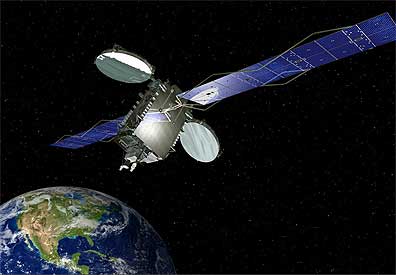
SES-2
Having put behind them the union workers' strike at French Guiana which led to the delay of the launch by one day the telecommunications satellites for two key Arianespace customers were launched tonight on the company’s fifth Ariane 5 flight of 2011, extending the heavy-lift workhorse’s string of consecutive successes to 46.
Delivering a total payload lift performance of approximately 8,975 kg., the mission lofted Arabsat-5C for the Arab Satellite Communications Organization (Arabsat) and SES-2, which will be utilized by Europe’s SES. Arabsat-5C was deployed first, separating from Ariane 5 at 27 minutes after liftoff, followed eight minutes later by SES-2.
“Arabsat decided several years ago to entrust us with the launch of all its satellites, and the successful orbiting of this eighth satellite demonstrates that my friend, Khalid Balkheyour, Arabsat’s President and CEO, was right to place his confidence in us,” said Arianespace Chairman & CEO Jean-Yves Le Gall. “Because of his wise choice, Arabsat has become one of the world’s leading operators — and I congratulate it for this superb success.”

SES-2 is based on Orbital’s space-proven Star 2.4 platform, the largest and most powerful geostationary communications satellites Orbital builds. It carries 24 C-Band transponders and 24 Ku-Band transponders (36 MHz equivalents), generates approximately five kilowatts of payload power, and features a design life of 15 years.
The SES-2 passenger for tonight’s mission was the 35th SES satellite launched by an Ariane vehicle, and is equipped with 24 C-band and 24 Ku-band transponders. It will replace SES’ AMC-3 spacecraft at 87 deg. West, providing coverage for North America and the Caribbean. Also integrated aboard SES-2 is the Commercially Hosted Infrared Payload (CHIRP) sensor for the U.S. Air Force — which integrates a wide-field of view sensor for testing by the military service. The CHIRP sensor features a fixed telescope that can view one quarter of the Earth from geosynchronous orbit.
"We overcame many challenges on the way to today's launch," said Col. Scott Beidleman, Space and Missile Systems Center's Development Planning Director. "This effort is unique because the CHIRP launch marks not only the first-ever commercially hosted payload for the Air Force, but also the first ever wide field-of-view infrared staring payload in space. I commend the CHIRP government and contractor teams for their dedication to mission success."
CHIRP is a technology maturation and risk reduction experiment to collect real-world data, investigate spacecraft-sensor interactions and sensor behavior in the space environment, explore operational issues relevant to these sensors, and evaluate long-term suitability of commercially hosted payloads. CHIRP will first power on approximately 30 days after launch, with on-orbit experiments to follow.
CHIRP technology is applicable to missile warning/defense, technical intelligence, and battlespace awareness missions. The CHIRP team is a government-industry collaboration led by the Air Force's Space and Missile System Center Development Planning Directorate. CHIRP is a pathfinder for both WFOV IR staring technologies and commercially hosted payloads.
Romain Bausch, President and CEO of SES, stated: “Roughly two months after the successful launch of SES-3, the launch success of SES-2 on Ariane marks another important event for SES’ North American customers, completing SES’ encompassing satellite fleet renewal over North America. SES would like to thank Arianespace and Orbital for a mission well executed. Fitted with CHIRP, SES’ first hosted payload, SES-2 is also an important demonstration of how hosting government special purpose payloads on commercial satellites can provide cost effective means for experimenting with new technologies.”
“We are particularly proud of the loyalty that SES has demonstrated since more than 20 years, and I wish to particularly thank Tip Osterthaler, the President and CEO of SES WORLD SKIES U.S. Government Solutions,” Le Gall said. “I also want to thank our friends at the U.S. Air Force, because together, we have opened a new chapter for the space industry tonight in launching CHIRP on SES-2 as the initial military payload on a civilian satellite. Arianespace is honored to once again be part of a world’s first!”
After tonight’s success, Arianespace is to follow with another historic milestone: the maiden liftoff of Soyuz from French Guiana, scheduled for October 20. The Russian-built medium-lift vehicle will orbit two Galileo spacecraft for Europe’s satellite-based navigation system. The next Ariane 5 flight is planned for early 2012, performing its third mission to loft a European Automated Transfer Vehicle (ATV) for servicing of the International Space Station.

